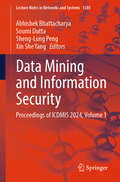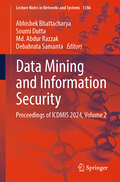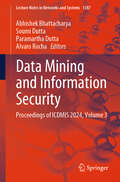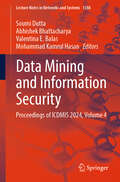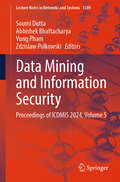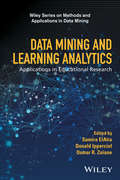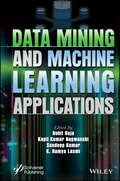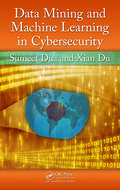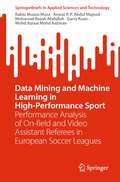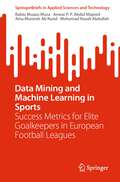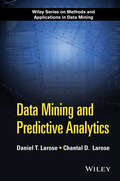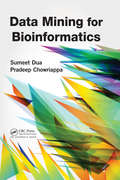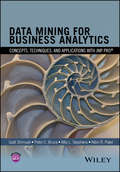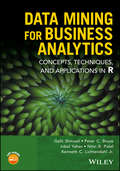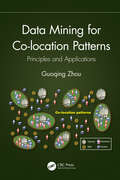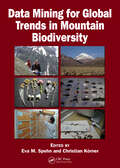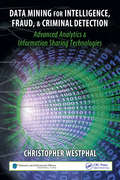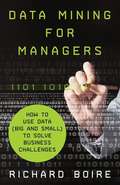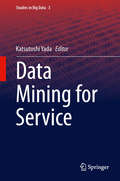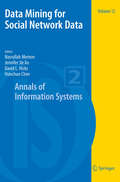- Table View
- List View
Data Mining and Information Security: Proceedings of ICDMIS 2024, Volume 1 (Lecture Notes in Networks and Systems #1385)
by Sheng-Lung Peng Abhishek Bhattacharya Soumi Dutta Xin She YangThis book features research papers presented at the International Conference on Data Mining and Information Security (ICDMIS 2024) held at Eminent College of Management and Technology (ECMT), West Bengal, India, during October 7–8, 2024. The book is organized in five volumes and includes high-quality research work by academicians and industrial experts in the field of computing and communication, including full-length papers, research-in-progress papers, and case studies related to all the areas of data mining, machine learning, Internet of Things (IoT), and information security.
Data Mining and Information Security: Proceedings of ICDMIS 2024, Volume 2 (Lecture Notes in Networks and Systems #1386)
by Abhishek Bhattacharya Soumi Dutta Debabrata Samanta Md Abdur RazzakThis book features research papers presented at the International Conference on Data Mining and Information Security (ICDMIS 2024) held at Eminent College of Management and Technology (ECMT), West Bengal, India, during October 7–8, 2024. The book is organized in five volumes and includes high-quality research work by academicians and industrial experts in the field of computing and communication, including full-length papers, research-in-progress papers and case studies related to all the areas of data mining, machine learning, Internet of Things (IoT) and information security.
Data Mining and Information Security: Proceedings of ICDMIS 2024, Volume 3 (Lecture Notes in Networks and Systems #1387)
by Paramartha Dutta Abhishek Bhattacharya Soumi Dutta Alvaro RochaThis book features research papers presented at the International Conference on Data Mining and Information Security (ICDMIS 2024) held at Eminent College of Management and Technology (ECMT), West Bengal, India, during October 7–8, 2024. The book is organized in five volumes and includes high-quality research work by academicians and industrial experts in the field of computing and communication, including full-length papers, research-in-progress papers and case studies related to all the areas of data mining, machine learning, Internet of Things (IoT) and information security.
Data Mining and Information Security: Proceedings of ICDMIS 2024, Volume 4 (Lecture Notes in Networks and Systems #1388)
by Valentina E. Balas Abhishek Bhattacharya Soumi Dutta Mohammad Kamrul HasanThis book features research papers presented at the International Conference on Data Mining and Information Security (ICDMIS 2024) held at Eminent College of Management and Technology (ECMT), West Bengal, India, during October 7–8, 2024. The book is organized in five volumes and includes high-quality research work by academicians and industrial experts in the field of computing and communication, including full-length papers, research-in-progress papers and case studies related to all the areas of data mining, machine learning, Internet of Things (IoT) and information security.
Data Mining and Information Security: Proceedings of ICDMIS 2024, Volume 5 (Lecture Notes in Networks and Systems #1389)
by Abhishek Bhattacharya Soumi Dutta Zdzislaw Polkowski Vung PhamThis book features research papers presented at the International Conference on Data Mining and Information Security (ICDMIS 2024) held at Eminent College of Management and Technology (ECMT), West Bengal, India, during October 7–8, 2024. The book is organized in five volumes and includes high-quality research work by academicians and industrial experts in the field of computing and communication, including full-length papers, research-in-progress papers and case studies related to all the areas of data mining, machine learning, Internet of Things (IoT) and information security.
Data Mining and Learning Analytics: Applications in Educational Research
by Donald Ipperciel Samira Elatia Osmar R. ZaïaneAddresses the impacts of data mining on education and reviews applications in educational research teaching, and learning This book discusses the insights, challenges, issues, expectations, and practical implementation of data mining (DM) within educational mandates. Initial series of chapters offer a general overview of DM, Learning Analytics (LA), and data collection models in the context of educational research, while also defining and discussing data mining's four guiding principles-- prediction, clustering, rule association, and outlier detection. The next series of chapters showcase the pedagogical applications of Educational Data Mining (EDM) and feature case studies drawn from Business, Humanities, Health Sciences, Linguistics, and Physical Sciences education that serve to highlight the successes and some of the limitations of data mining research applications in educational settings. The remaining chapters focus exclusively on EDM's emerging role in helping to advance educational research--from identifying at-risk students and closing socioeconomic gaps in achievement to aiding in teacher evaluation and facilitating peer conferencing. This book features contributions from international experts in a variety of fields. Includes case studies where data mining techniques have been effectively applied to advance teaching and learning Addresses applications of data mining in educational research, including: social networking and education; policy and legislation in the classroom; and identification of at-risk students Explores Massive Open Online Courses (MOOCs) to study the effectiveness of online networks in promoting learning and understanding the communication patterns among users and students Features supplementary resources including a primer on foundational aspects of educational mining and learning analytics Data Mining and Learning Analytics: Applications in Educational Research is written for both scientists in EDM and educators interested in using and integrating DM and LA to improve education and advance educational research. Samira ElAtia is Associate Professor of Education at The University of Alberta, Canada. She has published numerous articles and book chapters on topics relating to the use of technology to support pedagogical research and education in higher education. Her current research focuses on using e-learning environment and big data for fair and valid longitudinal assessment of, and for, learning within higher education. Donald Ipperciel is Principal and Professor at Glendon College, York University, Toronto, Canada and was the Canadian Research Chair in Political Philosophy and Canadian Studies between 2002 and 2012. He has authored several books and has contributed chapters and articles in more than 60 publications. Ipperciel has dedicated many years of research on the questions of e-learning and using technology in education. He is co-editor of the Canadian Journal of Learning and Technology since 2010. Osmar R. Zaïane is Professor of Computing Science at the University of Alberta, Canada and Scientific Director of the Alberta Innovates Centre of Machine Learning. A renowned researcher and computer scientist, Dr. Zaiane is former Secretary Treasurer of the Association for Computing Machinery (ACM) Special Interest Group on Knowledge Discovery and Data Mining. He obtained the IEEE ICDM Outstanding Service Aware in 2009 as well as the ACM SIGKDD Service Award the following year.
Data Mining and Machine Learning Applications
by Sandeep Kumar Rohit Raja K. Ramya Laxmi Kapil Kumar NagwanshiDATA MINING AND MACHINE LEARNING APPLICATIONS The book elaborates in detail on the current needs of data mining and machine learning and promotes mutual understanding among research in different disciplines, thus facilitating research development and collaboration. Data, the latest currency of today’s world, is the new gold. In this new form of gold, the most beautiful jewels are data analytics and machine learning. Data mining and machine learning are considered interdisciplinary fields. Data mining is a subset of data analytics and machine learning involves the use of algorithms that automatically improve through experience based on data. Massive datasets can be classified and clustered to obtain accurate results. The most common technologies used include classification and clustering methods. Accuracy and error rates are calculated for regression and classification and clustering to find actual results through algorithms like support vector machines and neural networks with forward and backward propagation. Applications include fraud detection, image processing, medical diagnosis, weather prediction, e-commerce and so forth. The book features: A review of the state-of-the-art in data mining and machine learning, A review and description of the learning methods in human-computer interaction, Implementation strategies and future research directions used to meet the design and application requirements of several modern and real-time applications for a long time, The scope and implementation of a majority of data mining and machine learning strategies. A discussion of real-time problems. Audience Industry and academic researchers, scientists, and engineers in information technology, data science and machine and deep learning, as well as artificial intelligence more broadly.
Data Mining and Machine Learning in Building Energy Analysis
by Frédéric Magoules Hai-Xiang ZhaoFocusing on up-to-date artificial intelligence models to solve building energy problems, Artificial Intelligence for Building Energy Analysis reviews recently developed models for solving these issues, including detailed and simplified engineering methods, statistical methods, and artificial intelligence methods. The text also simulates energy consumption profiles for single and multiple buildings. Based on these datasets, Support Vector Machine (SVM) models are trained and tested to do the prediction. Suitable for novice, intermediate, and advanced readers, this is a vital resource for building designers, engineers, and students.
Data Mining and Machine Learning in Cybersecurity
by Sumeet Dua Xian DuWith the rapid advancement of information discovery techniques, machine learning and data mining continue to play a significant role in cybersecurity. Although several conferences, workshops, and journals focus on the fragmented research topics in this area, there has been no single interdisciplinary resource on past and current works and possible
Data Mining and Machine Learning in High-Performance Sport: Performance Analysis of On-field and Video Assistant Referees in European Soccer Leagues (SpringerBriefs in Applied Sciences and Technology)
by Mohamad Razali Abdullah Mohd Azraai Mohd Razman Rabiu Muazu Musa Anwar P.P. Abdul Majeed Garry KuanThis book explores the application of data mining and machine learning techniques in studying the activity pattern, decision-making skills, misconducts, and actions resulting in the intervention of VAR in European soccer leagues referees. The game of soccer at the elite level is characterised by intense competitions, a high level of intensity, technical, and tactical skills coupled with a long duration of play. Referees are required to officiate the game and deliver correct and indisputable decisions throughout the duration of play. The increase in the spatial and temporal task demands of the game necessitates that the referees must respond and cope with the physiological and psychological loads inherent in the game. The referees are also required to deliver an accurate decision and uphold the rules and regulations of the game during a match. These demands and attributes make the work of referees highly complex. The increasing pace and complexity of the game resulted in the introduction of the Video Assistant Referee (VAR) to assist and improve the decision-making of on-field referees. Despite the integration of VAR into the current refereeing system, the performances of the referees are yet to be error-free. Machine learning coupled with data mining techniques has shown to be vital in providing insights from a large dataset which could be used to draw important inferences that can aid decision-making for diagnostics purposes and overall performance improvement. A total of 6232 matches from 5 consecutive seasons officiated across the English Premier League, Spanish LaLiga, Italian Serie A as well as the German Bundesliga was studied. It is envisioned that the findings in this book could be useful in recognising the activity pattern of top-class referees, that is non-trivial for the stakeholders in devising strategies to further enhance the performances of referees as well as empower talent identification experts with pertinent information for mapping out future high-performance referees.
Data Mining and Machine Learning in Sports: Success Metrics for Elite Goalkeepers in European Football Leagues (SpringerBriefs in Applied Sciences and Technology)
by Rabiu Muazu Musa Mohamad Razali Abdullah Anwar P. Majeed Aina Munirah Ab RasidThis brief highlights the factors associated with good goalkeeping techniques and their impact on goalkeepers’ performance in elite European football leagues. The goalkeeping performances of 1600 goalkeepers from five consecutive seasons across the English Premier League, Spanish La Liga, Italian Serie A, and German Bundesliga are studied. The findings from this brief are useful for identifying the success metrices of top-class goalkeepers that help stakeholders to devise strategies to further enhance their performances and empower talent identification experts with pertinent information for mapping out future high-performance goalkeepers.
Data Mining and Predictive Analytics
by Daniel T. Larose Chantal D. LaroseLearn methods of data analysis and their application to real-world data sets This updated second edition serves as an introduction to data mining methods and models, including association rules, clustering, neural networks, logistic regression, and multivariate analysis. The authors apply a unified "white box" approach to data mining methods and models. This approach is designed to walk readers through the operations and nuances of the various methods, using small data sets, so readers can gain an insight into the inner workings of the method under review. Chapters provide readers with hands-on analysis problems, representing an opportunity for readers to apply their newly-acquired data mining expertise to solving real problems using large, real-world data sets. Data Mining and Predictive Analytics, Second Edition: Offers comprehensive coverage of association rules, clustering, neural networks, logistic regression, multivariate analysis, and R statistical programming language Features over 750 chapter exercises, allowing readers to assess their understanding of the new material Provides a detailed case study that brings together the lessons learned in the book Includes access to the companion website, www.dataminingconsultant, with exclusive password-protected instructor content Data Mining and Predictive Analytics, Second Edition will appeal to computer science and statistic students, as well as students in MBA programs, and chief executives. rose is a Ph.D. candidate in Statistics at the University of Connecticut. Her research focuses on the imputation of missing data and model-based clustering. She has taught undergraduate statistics since 2011, and is a statistical consultant for DataMiningConsultant.com, LLC.
Data Mining and Statistics for Decision Making (Wiley Series In Computational Statistics Ser. #711)
by Stéphane TufféryData mining is the process of automatically searching large volumes of data for models and patterns using computational techniques from statistics, machine learning and information theory; it is the ideal tool for such an extraction of knowledge. Data mining is usually associated with a business or an organization's need to identify trends and profiles, allowing, for example, retailers to discover patterns on which to base marketing objectives.This book looks at both classical and recent techniques of data mining, such as clustering, discriminant analysis, logistic regression, generalized linear models, regularized regression, PLS regression, decision trees, neural networks, support vector machines, Vapnik theory, naive Bayesian classifier, ensemble learning and detection of association rules. They are discussed along with illustrative examples throughout the book to explain the theory of these methods, as well as their strengths and limitations. Key Features:Presents a comprehensive introduction to all techniques used in data mining and statistical learning, from classical to latest techniques.Starts from basic principles up to advanced concepts.Includes many step-by-step examples with the main software (R, SAS, IBM SPSS) as well as a thorough discussion and comparison of those software.Gives practical tips for data mining implementation to solve real world problems.Looks at a range of tools and applications, such as association rules, web mining and text mining, with a special focus on credit scoring.Supported by an accompanying website hosting datasets and user analysis. Statisticians and business intelligence analysts, students as well as computer science, biology, marketing and financial risk professionals in both commercial and government organizations across all business and industry sectors will benefit from this book.
Data Mining for Bioinformatics
by Sumeet Dua Pradeep ChowriappaCovering theory, algorithms, and methodologies, as well as data mining technologies, Data Mining for Bioinformatics provides a comprehensive discussion of data-intensive computations used in data mining with applications in bioinformatics. It supplies a broad, yet in-depth, overview of the application domains of data mining for bioinformatics to he
Data Mining for Business Analytics: Concepts, Techniques, And Applications In Jmp
by Galit Shmueli Peter C. Bruce Nitin R. Patel Mia L. StephensData Mining for Business Analytics: Concepts, Techniques, and Applications with JMP Pro® presents an applied and interactive approach to data mining. Featuring hands-on applications with JMP Pro®, a statistical package from the SAS Institute, the bookuses engaging, real-world examples to build a theoretical and practical understanding of key data mining methods, especially predictive models for classification and prediction. Topics include data visualization, dimension reduction techniques, clustering, linear and logistic regression, classification and regression trees, discriminant analysis, naive Bayes, neural networks, uplift modeling, ensemble models, and time series forecasting. Data Mining for Business Analytics: Concepts, Techniques, and Applications with JMP Pro® also includes: Detailed summaries that supply an outline of key topics at the beginning of each chapter End-of-chapter examples and exercises that allow readers to expand their comprehension of the presented material Data-rich case studies to illustrate various applications of data mining techniques A companion website with over two dozen data sets, exercises and case study solutions, and slides for instructors Data Mining for Business Analytics: Concepts, Techniques, and Applications with JMP Pro® is an excellent textbook for advanced undergraduate and graduate-level courses on data mining, predictive analytics, and business analytics. The book is also a one-of-a-kind resource for data scientists, analysts, researchers, and practitioners working with analytics in the fields of management, finance, marketing, information technology, healthcare, education, and any other data-rich field. Galit Shmueli, PhD, is Distinguished Professor at National Tsing Hua University's Institute of Service Science. She has designed and instructed data mining courses since 2004 at University of Maryland, Statistics.com, Indian School of Business, and National Tsing Hua University, Taiwan. Professor Shmueli is known for her research and teaching in business analytics, with a focus on statistical and data mining methods in information systems and healthcare. She has authored over 70 journal articles, books, textbooks, and book chapters, including Data Mining for Business Analytics: Concepts, Techniques, and Applications in XLMiner®, Third Edition, also published by Wiley. Peter C. Bruce is President and Founder of the Institute for Statistics Education at www.statistics.com He has written multiple journal articles and is the developer of Resampling Stats software. He is the author of Introductory Statistics and Analytics: A Resampling Perspective and co-author of Data Mining for Business Analytics: Concepts, Techniques, and Applications in XLMiner ®, Third Edition, both published by Wiley. Mia Stephens is Academic Ambassador at JMP®, a division of SAS Institute. Prior to joining SAS, she was an adjunct professor of statistics at the University of New Hampshire and a founding member of the North Haven Group LLC, a statistical training and consulting company. She is the co-author of three other books, including Visual Six Sigma: Making Data Analysis Lean, Second Edition, also published by Wiley. Nitin R. Patel, PhD, is Chairman and cofounder of Cytel, Inc., based in Cambridge, Massachusetts. A Fellow of the American Statistical Association, Dr. Patel has also served as a Visiting Professor at the Massachusetts Institute of Technology and at Harvard University. He is a Fellow of the Computer Society of India and was a professor at the Indian Institute of Management, Ahmedabad, for 15 years. He is co-author of Data Mining for Business Analytics: Concepts, Techniques, and Applications in XLMiner®, Third Edition, also published by Wiley.
Data Mining for Business Analytics: Concepts, Techniques, And Applications In R
by Galit Shmueli Peter C. Bruce Nitin R. Patel Inbal Yahav Kenneth C. Lichtendahl Jr.Data Mining for Business Analytics: Concepts, Techniques, and Applications in R presents an applied approach to data mining concepts and methods, using R software for illustration Readers will learn how to implement a variety of popular data mining algorithms in R (a free and open-source software) to tackle business problems and opportunities. This is the fifth version of this successful text, and the first using R. It covers both statistical and machine learning algorithms for prediction, classification, visualization, dimension reduction, recommender systems, clustering, text mining and network analysis. It also includes: • Two new co-authors, Inbal Yahav and Casey Lichtendahl, who bring both expertise teaching business analytics courses using R, and data mining consulting experience in business and government • Updates and new material based on feedback from instructors teaching MBA, undergraduate, diploma and executive courses, and from their students • More than a dozen case studies demonstrating applications for the data mining techniques described • End-of-chapter exercises that help readers gauge and expand their comprehension and competency of the material presented • A companion website with more than two dozen data sets, and instructor materials including exercise solutions, PowerPoint slides, and case solutions Data Mining for Business Analytics: Concepts, Techniques, and Applications in R is an ideal textbook for graduate and upper-undergraduate level courses in data mining, predictive analytics, and business analytics. This new edition is also an excellent reference for analysts, researchers, and practitioners working with quantitative methods in the fields of business, finance, marketing, computer science, and information technology. “ This book has by far the most comprehensive review of business analytics methods that I have ever seen, covering everything from classical approaches such as linear and logistic regression, through to modern methods like neural networks, bagging and boosting, and even much more business specific procedures such as social network analysis and text mining. If not the bible, it is at the least a definitive manual on the subject.” Gareth M. James, University of Southern California and co-author (with Witten, Hastie and Tibshirani) of the best-selling book An Introduction to Statistical Learning, with Applications in R Galit Shmueli, PhD, is Distinguished Professor at National Tsing Hua University’s Institute of Service Science. She has designed and instructed data mining courses since 2004 at University of Maryland, Statistics.com, Indian School of Business, and National Tsing Hua University, Taiwan. Professor Shmueli is known for her research and teaching in business analytics, with a focus on statistical and data mining methods in information systems and healthcare. She has authored over 70 publications including books. Peter C. Bruce is President and Founder of the Institute for Statistics Education at Statistics.com. He has written multiple journal articles and is the developer of Resampling Stats software. He is the author of Introductory Statistics and Analytics: A Resampling Perspective (Wiley) and co-author of Practical Statistics for Data Scientists: 50 Essential Concepts (O’Reilly). Inbal Yahav, PhD, is Professor at the Graduate School of Business Administration at Bar-Ilan University, Israel. She teaches courses in social network analysis, advanced research methods, and software quality assurance. Dr. Yahav received her PhD in Operations Research and Data Mining from the University of Maryland, College Park. Nitin R. Patel, PhD, is Chairman and cofounder of Cytel, Inc., based in Cambridge, Massachusetts. A Fellow of the American St
Data Mining for Business Intelligence
by Galit Shmueli Peter C. Bruce Nitin R. PatelPraise for the First Edition" full of vivid and thought-provoking anecdotes needs to be read by anyone with a serious interest in research and marketing."--Research magazine"Shmueli et al. have done a wonderful job in presenting the field of data mining a welcome addition to the literature."--computingreviews.comIncorporating a new focus on data visualization and time series forecasting, Data Mining for Business Intelligence, Second Edition continues to supply insightful, detailed guidance on fundamental data mining techniques. This new edition guides readers through the use of the Microsoft Office Excel add-in XLMiner for developing predictive models and techniques for describing and finding patterns in data.From clustering customers into market segments and finding the characteristics of frequent flyers to learning what items are purchased with other items, the authors use interesting, real-world examples to build a theoretical and practical understanding of key data mining methods, including classification, prediction, and affinity analysis as well as data reduction, exploration, and visualization.The Second Edition now features:Three new chapters on time series forecasting, introducing popular business forecasting methods including moving average, exponential smoothing methods; regression-based models; and topics such as explanatory vs. predictive modeling, two-level models, and ensemblesA revised chapter on data visualization that now features interactive visualization principles and added assignments that demonstrate interactive visualization in practiceSeparate chapters that each treat k-nearest neighbors and Naïve Bayes methodsSummaries at the start of each chapter that supply an outline of key topicsThe book includes access to XLMiner, allowing readers to work hands-on with the provided data. Throughout the book, applications of the discussed topics focus on the business problem as motivation and avoid unnecessary statistical theory. Each chapter concludes with exercises that allow readers to assess their comprehension of the presented material. The final chapter includes a set of cases that require use of the different data mining techniques, and a related Web site features data sets, exercise solutions, PowerPoint slides, and case solutions.Data Mining for Business Intelligence, Second Edition is an excellent book for courses on data mining, forecasting, and decision support systems at the upper-undergraduate and graduate levels. It is also a one-of-a-kind resource for analysts, researchers, and practitioners working with quantitative methods in the fields of business, finance, marketing, computer science, and information technology.
Data Mining for Co-location Patterns: Principles and Applications
by Guoqing ZhouCo-location pattern mining detects sets of features frequently located in close proximity to each other. This book focuses on data mining for co-location pattern, a valid method for identifying patterns from all types of data and applying them in business intelligence and analytics. It explains the fundamentals of co-location pattern mining, co-location decision tree, and maximal instance co-location pattern mining along with an in-depth overview of data mining, machine learning, and statistics. This arrangement of chapters helps readers understand the methods of co-location pattern mining step-by-step and their applications in pavement management, image classification, geospatial buffer analysis, etc.
Data Mining for Design and Marketing (Chapman & Hall/CRC Data Mining and Knowledge Discovery Series)
by Katsutoshi Yada Yukio OhsawaData Mining for Design and Marketing shows how to design and integrate data mining tools into human thinking processes in order to make better business decisions, especially in designing and marketing products and systems.The expert contributors discuss how data mining can identify valuable consumer patterns, which aid marketers and designers in de
Data Mining for Geoinformatics: Methods and Applications
by Jessica Lin Guido Cervone Nigel WatersThe rate at which geospatial data is being generated exceeds our computational capabilities to extract patterns for the understanding of a dynamically changing world. Geoinformatics and data mining focuses on the development and implementation of computational algorithms to solve these problems. This unique volume contains a collection of chapters on state-of-the-art data mining techniques applied to geoinformatic problems of high complexity and important societal value. Data Mining for Geoinformatics addresses current concerns and developments relating to spatio-temporal data mining issues in remotely-sensed data, problems in meteorological data such as tornado formation, estimation of radiation from the Fukushima nuclear power plant, simulations of traffic data using OpenStreetMap, real time traffic applications of data stream mining, visual analytics of traffic and weather data and the exploratory visualization of collective, mobile objects such as the flocking behavior of wild chickens. This book is designed for researchers and advanced-level students focused on computer science, earth science and geography as a reference or secondary text book. Practitioners working in the areas of data mining and geoscience will also find this book to be a valuable reference.
Data Mining for Global Trends in Mountain Biodiversity
by Christian Körner Eva M. SpehnThanks to advances in electronic archiving of biodiversity data and the digitization of climate and other geophysical data, a new era in biogeography, functional ecology, and evolutionary ecology has begun. In Data Mining for Global Trends in Mountain Biodiversity, Christian Korner, Eva M. Spehn, and a team of experts from the Global Mountain Biodi
Data Mining for Intelligence, Fraud & Criminal Detection: Advanced Analytics & Information Sharing Technologies
by Christopher WestphalIn 2004, the Government Accountability Office provided a report detailing approximately 200 government-based data-mining projects. While there is comfort in knowing that there are many effective systems, that comfort isn‘t worth much unless we can determine that these systems are being effectively and responsibly employed.Written by one of the most
Data Mining for Managers
by Richard BoireBig Data is a growing business trend, but there little advice available on how to use it practically. Written by a data mining expert with over 30 years of experience, this book uses case studies to help marketers, brand managers and IT professionals understand how to capture and measure data for marketing purposes.
Data Mining for Service (Studies in Big Data #3)
by Katsutoshi YadaVirtually all nontrivial and modern service related problems and systems involve data volumes and types that clearly fall into what is presently meant as "big data", that is, are huge, heterogeneous, complex, distributed, etc. Data mining is a series of processes which include collecting and accumulating data, modeling phenomena, and discovering new information, and it is one of the most important steps to scientific analysis of the processes of services. Data mining application in services requires a thorough understanding of the characteristics of each service and knowledge of the compatibility of data mining technology within each particular service, rather than knowledge only in calculation speed and prediction accuracy. Varied examples of services provided in this book will help readers understand the relation between services and data mining technology. This book is intended to stimulate interest among researchers and practitioners in the relation between data mining technology and its application to other fields.
Data Mining for Social Network Data (Annals of Information Systems #12)
by Hsinchun Chen Nasrullah Memon David L. Hicks Jennifer Jie XuDriven by counter-terrorism efforts, marketing analysis and an explosion in online social networking in recent years, data mining has moved to the forefront of information science. This proposed Special Issue on Data Mining for Social Network Data will present a broad range of recent studies in social networking analysis. It will focus on emerging trends and needs in discovery and analysis of communities, solitary and social activities, activities in open for a and commercial sites as well. It will also look at network modeling, infrastructure construction, dynamic growth and evolution pattern discovery using machine learning approaches and multi-agent based simulations. Editors are three rising stars in world of data mining, knowledge discovery, social network analysis, and information infrastructures, and are anchored by Springer author/editor Hsinchun Chen (Terrorism Informatics; Medical Informatics; Digital Government), who is one of the most prominent intelligence analysis and data mining experts in the world.
